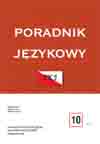Narty w historii języka polskiego
Narty (skis) in the history of the Polish language
Author(s): Wanda Decyk-ZiębaSubject(s): Language and Literature Studies
Published by: Dom Wydawniczy ELIPSA
Summary/Abstract: The history of the word narty (Ger. Schneeschuhe, Eng. skis) in the Polish language is extremely interesting. Its development reflects the complex history of Polish-Russian language contacts; in this case the role of the medium was played by Rerum Moscoviticarum commentarii by Siegmund von Herberstein. If assuming that narty acquired the meaning ‘boards for gliding over snow’ under the influence of Old Russian, rty, narty should be considered a semantic Russianism, even if a slightly camouflaged one. If rejecting such an interpretation, it needs to be accepted that narty is a (direct/indirect?) lexical borrowing from the Russian language or a neologism coined by Marcin Bielski. The word is recorded in the major old dictionaries of Polish, beginning with Knapski’s dictionary. They treat it first as a synonym of kośle and then łyże (later łyżwy); it denotes not only ‘Schneeschuhe’ but also ‘Schlittschuhe’. The emergence of Scandinavian skis on Polish lands at the end of the 19th c., which were called łyżwy śniegowe (snowskates) or ski at that time, changed the history of the word. After the World War II, it became a mere name of a designatum.
Journal: Poradnik Językowy
- Issue Year: 2013
- Issue No: 10
- Page Range: 5-21
- Page Count: 17
- Language: Polish
- Content File-PDF

